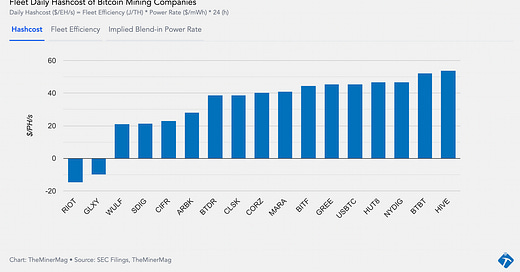Bitcoin Mining Hashcost, Explained
A new metric to give you a better outlook before the halving
Bitcoin’s hashprice set new yearly highs above $130/PH/s over the past week as mining companies are reaping an increasing amount of block rewards from transaction fees. As of writing, hashprice stands at $113/PH/s.
If we assume hashprice remains constant at $110/PH/s through April, it will be reduced to $55/PH/s right after the halving, which is now estimated to happen around April 23. What would that mean for bitcoin mining companies?
TheMinerMag has published a new hashcost metric to evaluate the competitiveness of mining companies. It is similar to the cost of bitcoin production metric but comes from a different perspective.
Just as the Luxor team’s hashprice chart captures bitcoin’s daily mining revenue in dollars per PH/s of hashrate, this hashcost metric shows how much money on average a mining company pays every day to operate each EH/s or PH/s of hashrate. Below is a quick formula:
Fleet Daily Hashcost ($/EH/s) = Fleet Efficiency (J/TH) * Power Rate ($/mWh) * 24 (Hours) = Cost of Bitcoin Production ($/BTC) * Daily Block Rewards (BTC) / Network Hashate (EH/s)
The chart below maps out the estimated average daily hashcost of mining companies in Q3. Bitcoin’s average hashprice in Q3 was around $70/PH/s, so most companies were fine. But those on the higher end of the scale will face much more uncertainty post-halving if they don’t reduce their hashcost.

So why do we need the hashcost metric? It takes the cost of bitcoin production metric a step further, extracting the value of a company’s fleet efficiency or its blend-in power rate when either of the two is known.
For instance, HIVE’s average daily hashcost was estimated to be $54/PH/s in Q3 and it reported a fleet efficiency to be 38 J/TH, which implies a blend-in power rate of $59.2/mWh. Similarly, Greenidge reported a Q3 hosting revenue to be $65/mWh. That was essentially the all-in power cost for NYDIG’s miners hosted with Greenidge, which implies the firm’s fleet efficiency to be 30 J/TH.
Reducing the hashcost by improving fleet efficiency and/or securing lower energy rates is hence paramount as the halving looms. That explains why we’re in the middle of an arms race among mining companies for the next generation of miners.
Hardware and Infrastructure News
Marathon Buys 390 MW Bitcoin Mining Sites for $178 Million – TheMinerMag
TSMC Chair Steps Down in Power Shift at Global Chip Linchpin - Bloomberg
Cipher Buys 7.1 EH/s for New Texas Bitcoin Mining Site - TheMinerMag
Iris Energy Preorders Enough Bitcoin Miners to Fulfill 10 EH/s Goal - TheMinerMag
HIVE Digital Buys 96 Nvidia H100 GPUs as Part of its AI and HPC Strategy - Link
Corporate News
Core Scientific Delays Final Hearing on Bankruptcy Exit to January - TheMinerMag
Financial News
Bitcoin Miners Eye $1.4 Billion in December Revenue - TheMinerMag
Bitcoin Miner Raised $15M to Use Energy from Argentina’s Vaca Muerta Oil Field - The Defiant
Feature
The Largest Immersion Mine In North America W/ Austin Storms - The Mining Pod
Ledger Exploit, Inscription Censorship and Ocean Pool W/ Thomas Pacchia & Drew Armstrong - The Mining Pod



Trying to understand the chart..are RIOT and GLXy making money had over fist? or am I misunderstanding the chart?